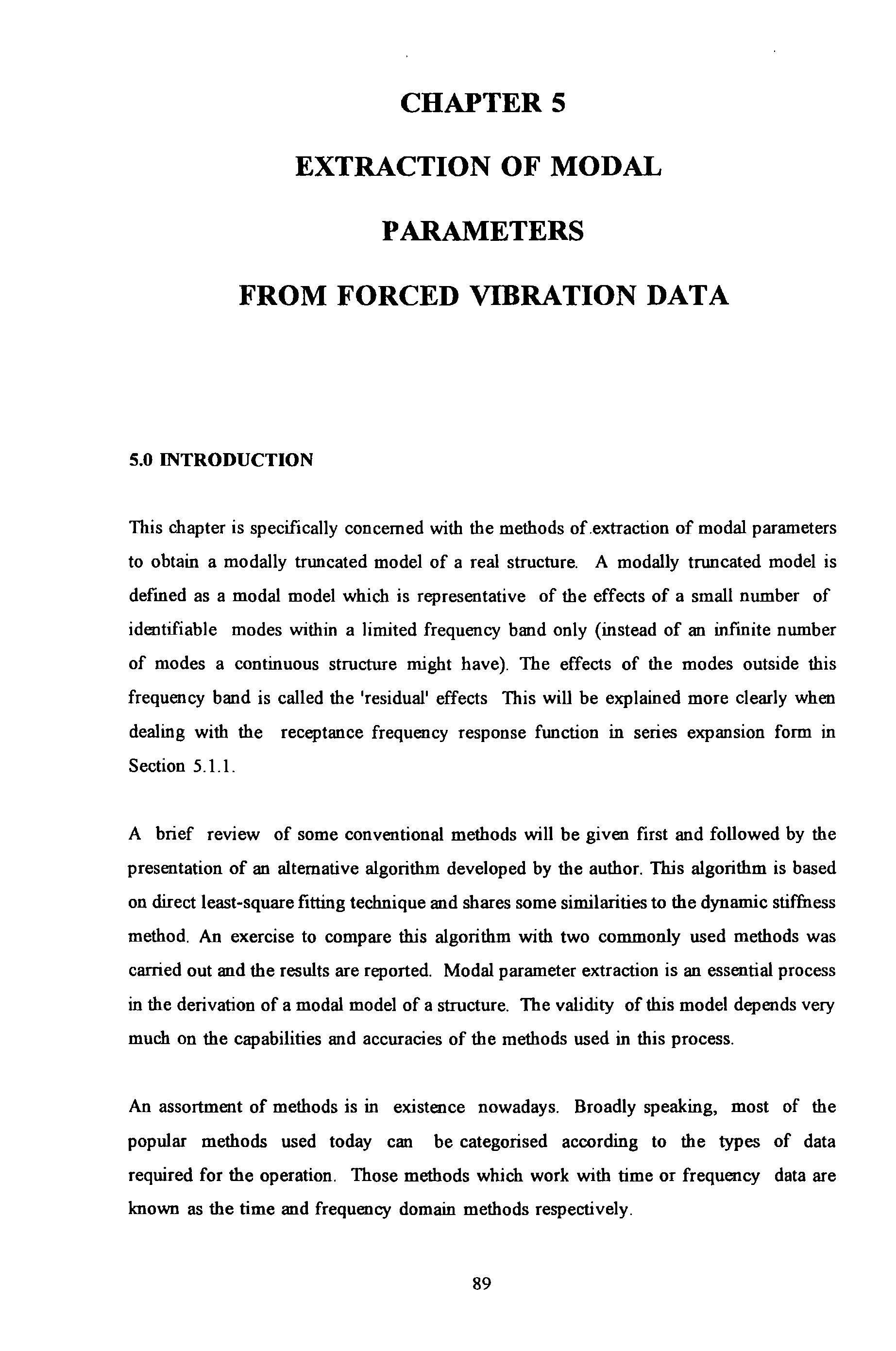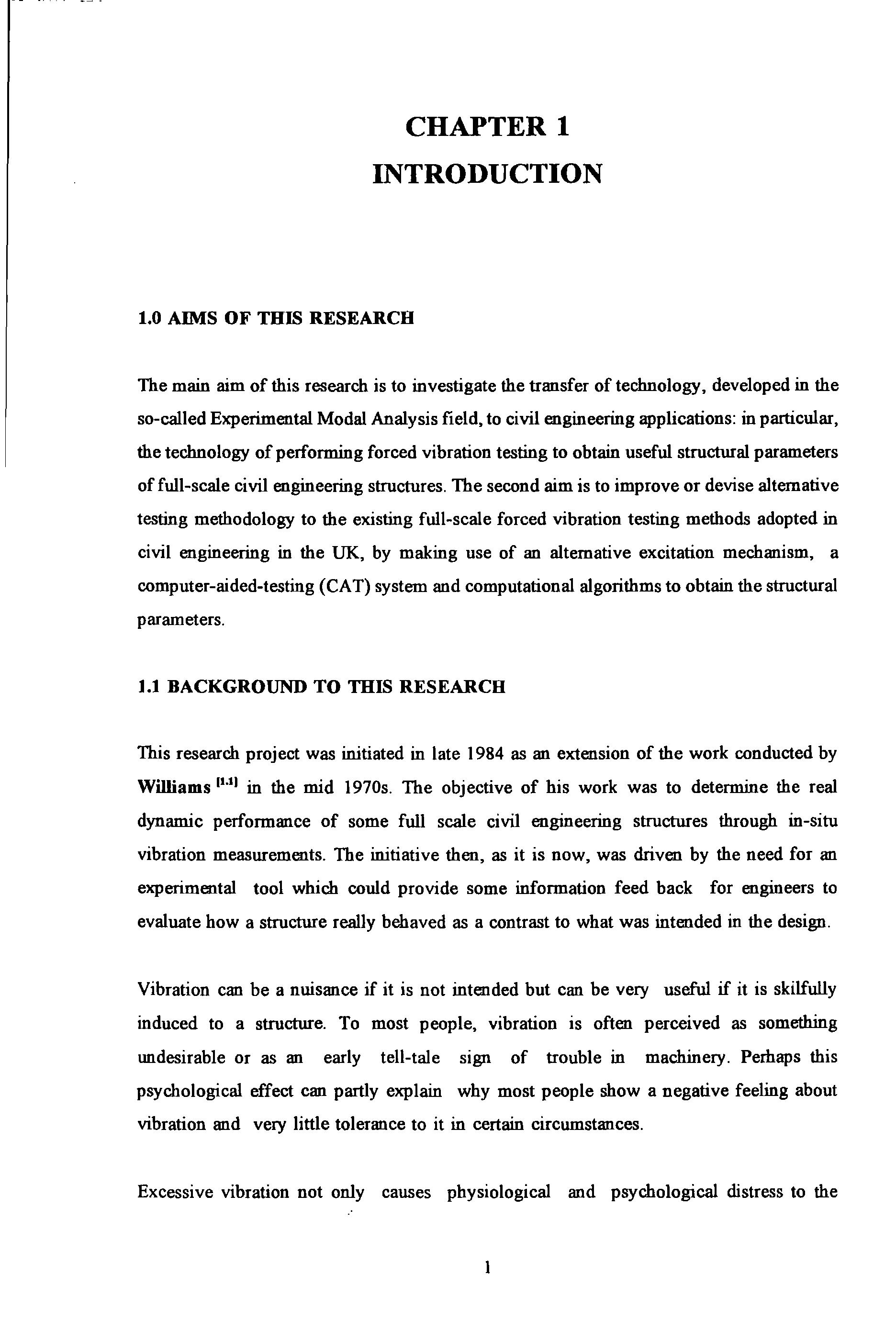
10 minute read
CHAPTER 1 INTRODUCTION
from Technique of Determination of Structural Parameters From Forced Vibration Testing
by Straam Group
1.0 AIMS OF THIS RESEARCH
The main aim of this research is to investigate the transfer of technology, developed in the so-called Experimental Modal Analysis field, to civil engineering applications: in particular, the technology of performing forced vibration testing to obtain useful structural parameters of full-scale civil engineering structures. The second aim is to improve or devise alternative testing methodology to the existing full-scale forced vibration testing methods adopted in civil engineering in the UK, by making use of an alternative excitation mechanism, a computer-aided-testing (CAT) system and computational algorithms to obtain the structural parameters.
Advertisement
1.1 BACKGROUND TO THIS RESEARCH
This research project was initiated in late 1984 as an extension of the work conducted by Williams JUJ in the mid 1970s. The objective of his work was to determine the real dynamic performance of some full scale civil engineering structures through in-situ vibration measurements. The initiative then, as it is now, was driven by the need for an experimental tool which could provide some information feed back for engineers to evaluate how a structure really behaved as a contrast to what was intended in the design.
Vibration can be a nuisance if it is not intended but can be very useful if it is skilfully induced to a structure. To most people, vibration is often perceived as something undesirable or as an early tell-tale sign of trouble in machinery. Perhaps this psychological effect can partly explain why most people show a negative feeling about vibration and very little tolerance to it in certain circumstances.
Excessive vibration not only causes physiological and psychological distress to the inhabitants of a vibrating structure, it also causes structural 'distress' such as fatigue and failure of the materials of the structure itself. Hence, most engineers are taught how to avoid or eliminate vibration during their education. Very little emphasis is placed on the advantages of vibration.
Structural dynamicists have for many years, used controlled vibration as an interrogation tool in the same way as stethoscopes are used by doctors. This technology is branched into several subsidiaries. One branch is called dynamic testing which is widely used in the aircraft and automobile industries. As vibration tests can often be carried out non-intrusively and non-destructively, it is a very useful structural diagnostic tool.
Another branch is called condition monitoring which utilizes the detection of undue vibration as an indication of the 'health condition' or otherwise of machineries. Condition monitoring is widely practised in the field of power generation and propulsion industries involving high speed rotational machinery. Knowing the true state of health of machines means a saving of expenditure on unnecessary re-fits and early detection of faults can prevent an expensive repair bill because further and more serious damage can be avoided. Without this technique, actions taken are either too prudent or too complacent but both actions produce the same expensive outcome.
Traditionally, civil/structural engineers have little training on vibration. Unlike structural statics which is taught in all civil/structural engineering courses, structural dynamics is often reserved only for the specialists. Given this background, it is not difficult to imagine that a dynamic problem is often transformed to a quasi-static problem for design and analysis. In Britain, wind loading design is covered by the British Standard Code of Practice CP3 ll.ll.
Early civil engineering structures, especially those constructed in Telford's and Brunei's times, were less prone to ambient induced vibration. Structures built today are, however, increasingly lighter in weight, more slender in shape and more flexible as a result of the use of lighter but stronger construction materials. Such structures are more vulnerable to vibration from natural causes such as wind and/or seismic activities.
Misunderstanding of the effects of vibration can sometimes be fatal. The static behaviour of a structure cannot and must not be used to extrapolate to the dynamic regime. A structure which is adequately designed for static loadings may not be adequate for dynamic loadings. The collapse of the Tacoma bridge was a typical example of such a tragedy. Critics often point their fingers at engineers for badly designed structures as the major promoter of misadventure. So a better understanding of the dynamics of structures is vital for the advancement of design and construction methods.
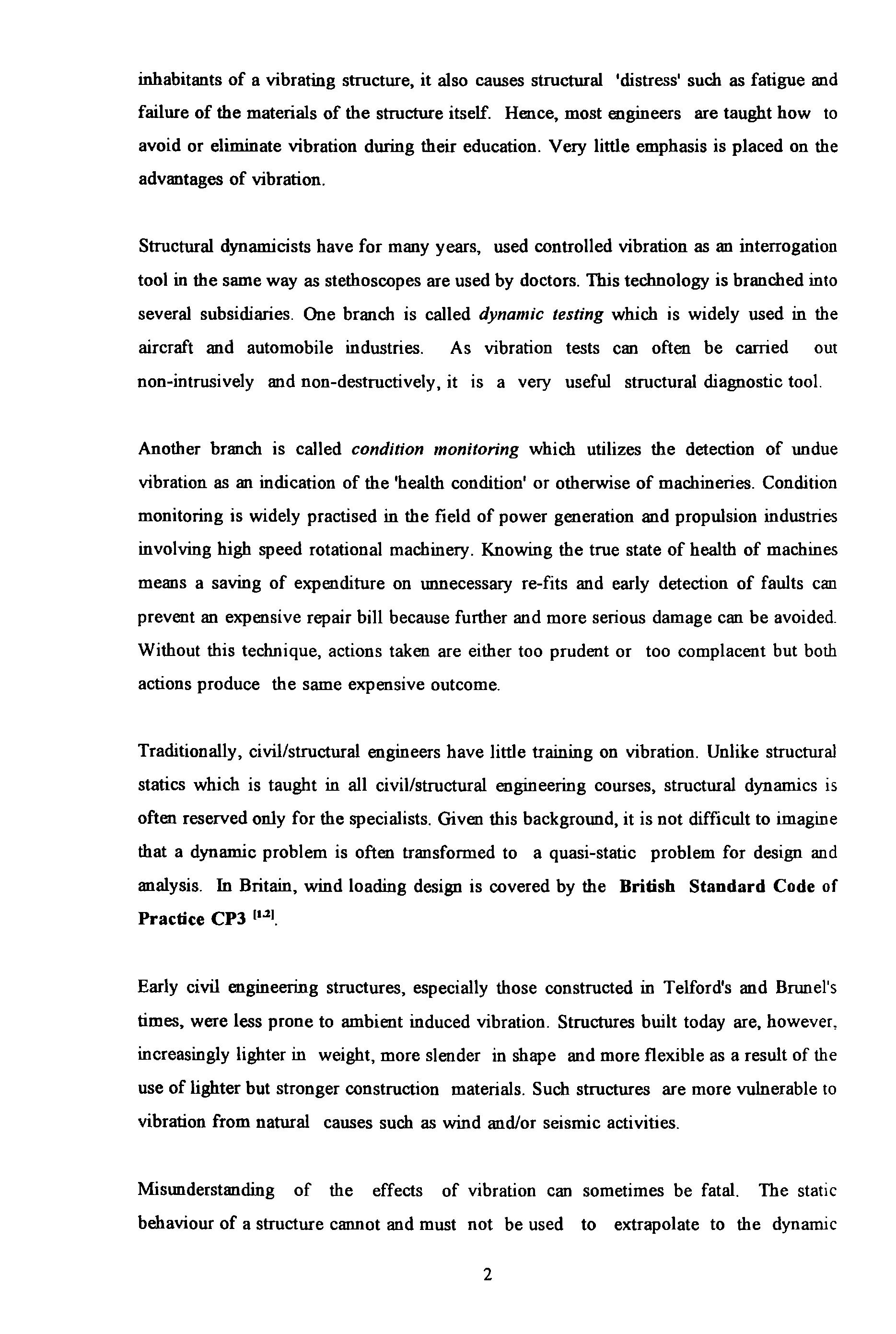
The following Sections introduce the theory and concept of forced vibration testing and explain how this technique can be applied.
1.2 AN OVERVIEW OF THE PROCESS OF MODELLING
Most investigative techniques, be they analytical or experimental in nature, can often be collectively described as modelling. Physical modelling which, often first springs to mind, is another modelling technique but is not of concern here. What is concerned here is mathematical modelling. Mathematical modelling is a prevalent task mutual to almost all analysis techniques. This exercise results in the realization of a complex system to a simplified conceptual model amenable to mathematical analysis.
Currently there are two mam approaches available in the field of structural dynamic modelling. One is theoretical, based on Finite Element Modelling (FEM) or Boundary Element Modelling (BEM) and the other is experimental, based on Experimental Modal Analysis (EMA ). FEM and BEM are instrumental in the modem practice of theoretical engineering analysis. However, recent advancement in instrumentation and signal processing technology is set to correct this imbalance. The dominance of analytical over experimental techniques is beginning to change.
FEM and BEM theories are based on a set of assumptions and idealizations upon which the feasibility and credibility of these methods depend entirely. The results of this analysis should never be accepted at their face values without the proper exercise of scrutiny. Otherwise, it is merely reduced to an unproductive "number crunching" exercise. Theoretical analysis alone cannot provide the sole solution to the need of a reliable engineering analysis tool. Other methods have to be sought to complement but not to substitute these theoretical techniques.
Experimental Modal Analysis which has been developing rapidly in another discipline, is a very promising technique. The experimental technique advocated in this research is based partly on EMA (modal approach) and partly on another alternative called spatial approach. Modal approach relies on the determination of the modal parameters (undamped natural frequencies, modal damping factors and modal constants for each of the modes of vibration of a structure) to construct a modal model. Whereas spatial approach determines the spatial parameters (mass, damping and stiffness matrices) to construct a spatial model. The two approaches share some similarities in methodology but differ in the ways that data analysis or parameter extraction is carried out. Further explanation of these two methods will be given in chapters 3, 5 and 6 accordingly.
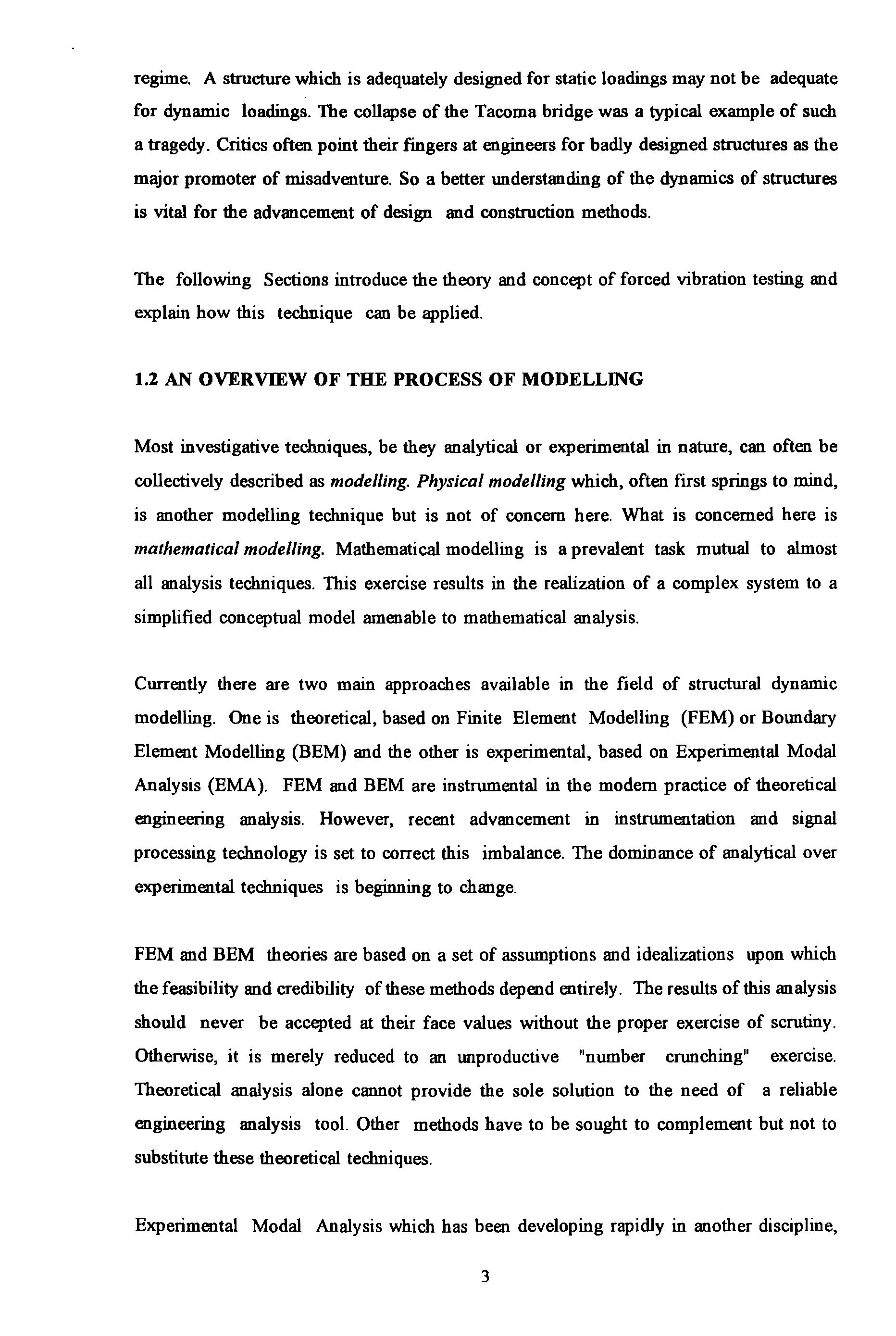
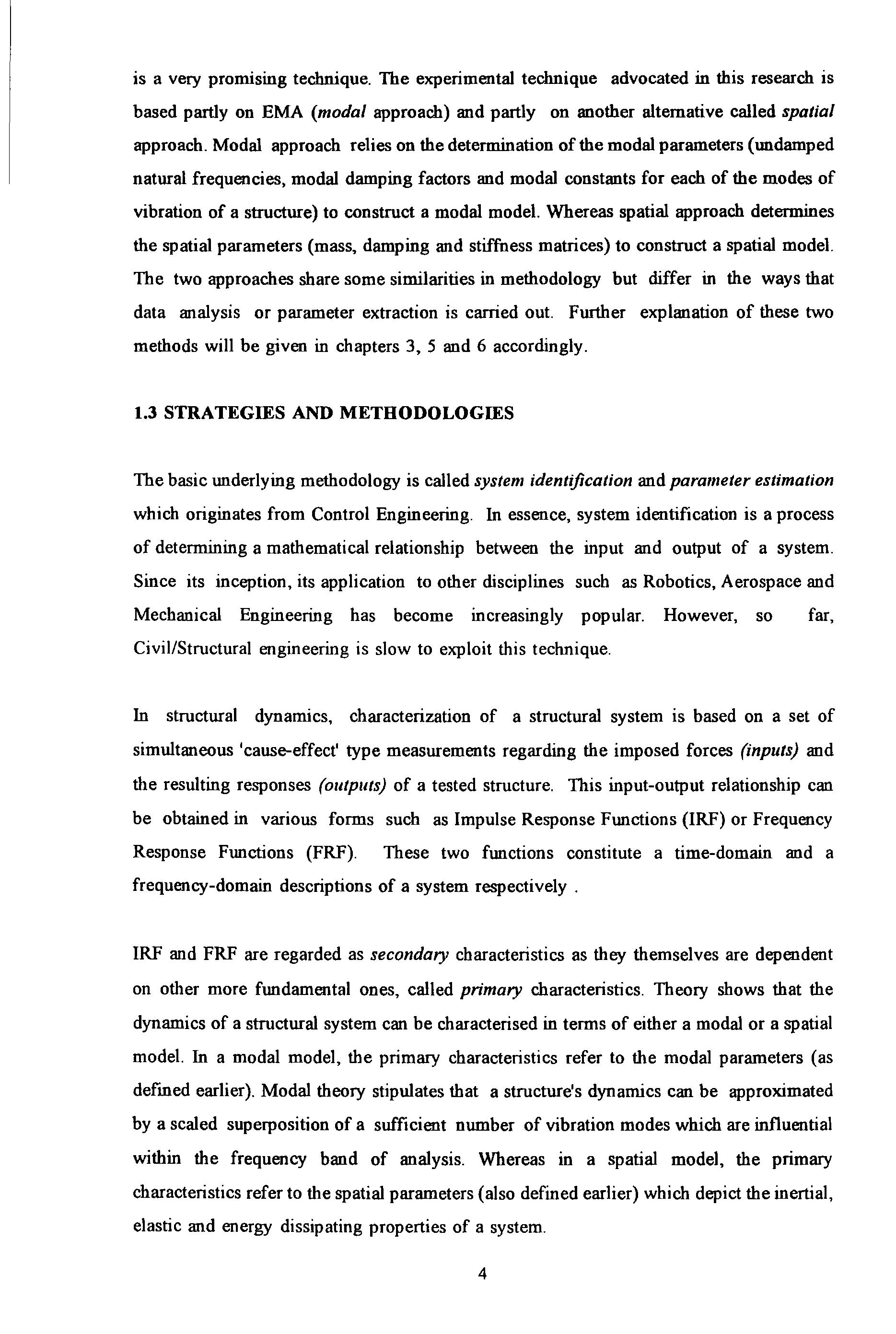
1.3 STRATEGIES AND METHODOLOGIES
The basic underlying methodology is called system identification and parameter estimation which originates from Control Engineering. In essence, system identification is a process of determining a mathematical relationship between the input and output of a system. Since its inception, its application to other disciplines such as Robotics, Aerospace and Mechanical Engineering has become increasingly popular. However, so far, Civil/Structural engineering is slow to exploit this technique.
In structural dynamics, characterization of a structural system is based on a set of simultaneous 'cause-effect' type measurements regarding the imposed forces (inputs) and the resulting responses (outputs) of a tested structure. This input-output relationship can be obtained in various forms such as Impulse Response Functions (IRF) or Frequency Response Functions (FRF). These two functions constitute a time-domain and a frequency-domain descriptions of a system respectively
IRF and FRF are regarded as secondary characteristics as they themselves are dependent on other more fundamental ones, called primary characteristics. Theory shows that the dynamics of a structural system can be characterised in terms of either a modal or a spatial model. In a modal model, the primary characteristics refer to the modal parameters (as defmed earlier). Modal theory stipulates that a structure's dynamics can be approximated by a scaled superposition of a sufficient number of vibration modes which are influential within the frequency band of analysis. Whereas in a spatial model, the primary characteristics refer to the spatial parameters (also defined earlier) which depict the inertial, elastic and energy dissipating properties of a system.
However, most of these parameters are 'latent' properties, usually not directly measurable quantities, and a computational algorithm is required to extract these parameters from the raw experimental FRF or IRF data. This extraction process is called parameter estimation. It enables a system's behaviour to be characterized based on only a handful of these parameters.
Having established a valid mathematical model, it enables either the imparted forces or the responses to be determined if the other one is known. Force detennination or response prediction are typical applications using this methodology.
Results and fmdings of a particular tested structure are more-or-less pertinent to that structure only and generalisation to other structures may not be allowed unless they are similar or identical in many respects. However civil engineering structures are rarely identical. Incurring research and development costs on a one-off product, rather than spreading them over millions of identical products such as cars, is often considered as uneconomical. A concerted and structured strategy is needed so that the individual test results can benefit the understanding of different forms of structures at large.
A so-called building block approach is fruitful to this end. Most structures are often built with simple and repetitive structural elements as building blocks. The understanding of the dynamics of these building blocks will help one to understand those of the structure as a whole.
The lack of understanding of some integral components of a structure has close bearing to some lapses in design philosophy and practice. Current practice often chooses to ignore the structural actions of the so-called non-structural elements believing that discounting their added strength is a prudent measure. With the cost of these elements often occupying a good proportion of the total construction costs, it make economic sense to find out if these discounted in-situ structural properties can be utilised in order to achieve optimum structural efficiency. In buildings, the structural actions of partition walls and exterior cladding have, for a long time, attracted strong interests. A number of investigations into the behaviour of cladding in tall buildings were undertaken by Oppenheim ll.Jl, Palsson ,._.., and Freeman IUI. But so far, the fmdings from these investigations are not comprehensive enough to warrant change in design practice.
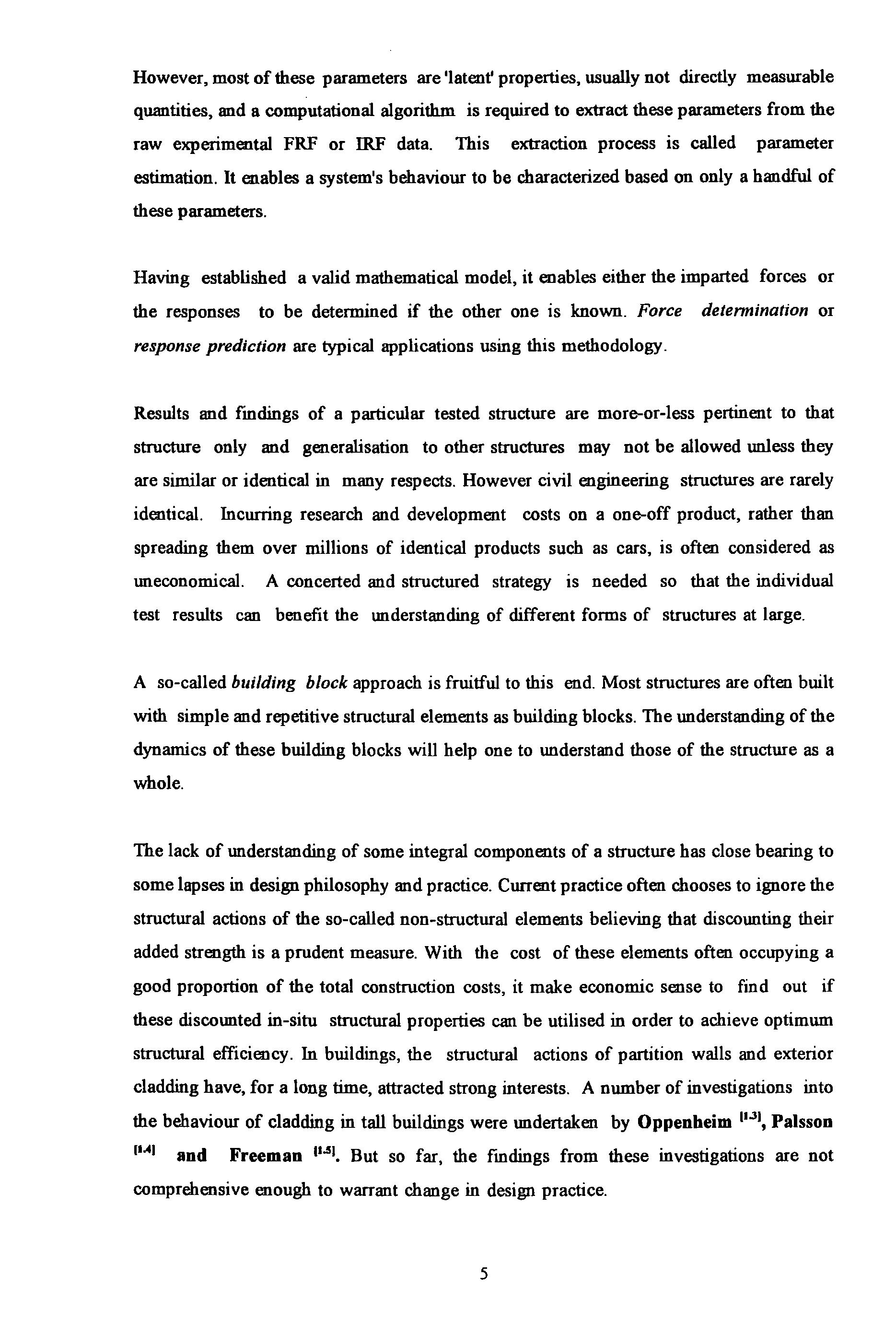
Similar efforts were reported by a number of earlier investigators such as Honda 1u 1 , Blume and Binder 11 •71 in the early 1960s. They studied the changes in stiffness of a number of structures by measuring the corresponding changes in the global modal characteristics following different construction stages. This approach is obviously limited by the impracticality of performing tests within a hectic construction schedule. It is also difficult to obtain good quality data when disturbance of the sort expected to be found in a construction site is so prominent.
Computational methods were also undertaken such as an investigation carried out by Mirtaheri. IUJ This investigation was based primarily on numerical parametric studies. By performing numerous iterative computations, he attempted to construct some feasible analytical models which could be reconciled with measured modal characteristics. This approach, inevitably by its very nature, is largely a 'hit-and-miss' exercise and it does not always guarantee success. Again, alternative strategies and methods are still required.
1.4 THE SCOPE OF THIS RESEARCH
The scope of this research covers both experimental and theoretical work. The task was tackled by research and development in a number of key areas. These key areas covered vibration generation, measurement and analysis which were all considered to be essential to achieve the following stated objectives : a. to develop an exciter which can excite large structures with random, sinusoidal or periodic forcing b. to incorporate computer control in full-scale tests in the field c. to develop algorithms which can extract useful information from forced vibration test data d. to use the developed system/technique to determine the real characteristics and performance of a full scale structure
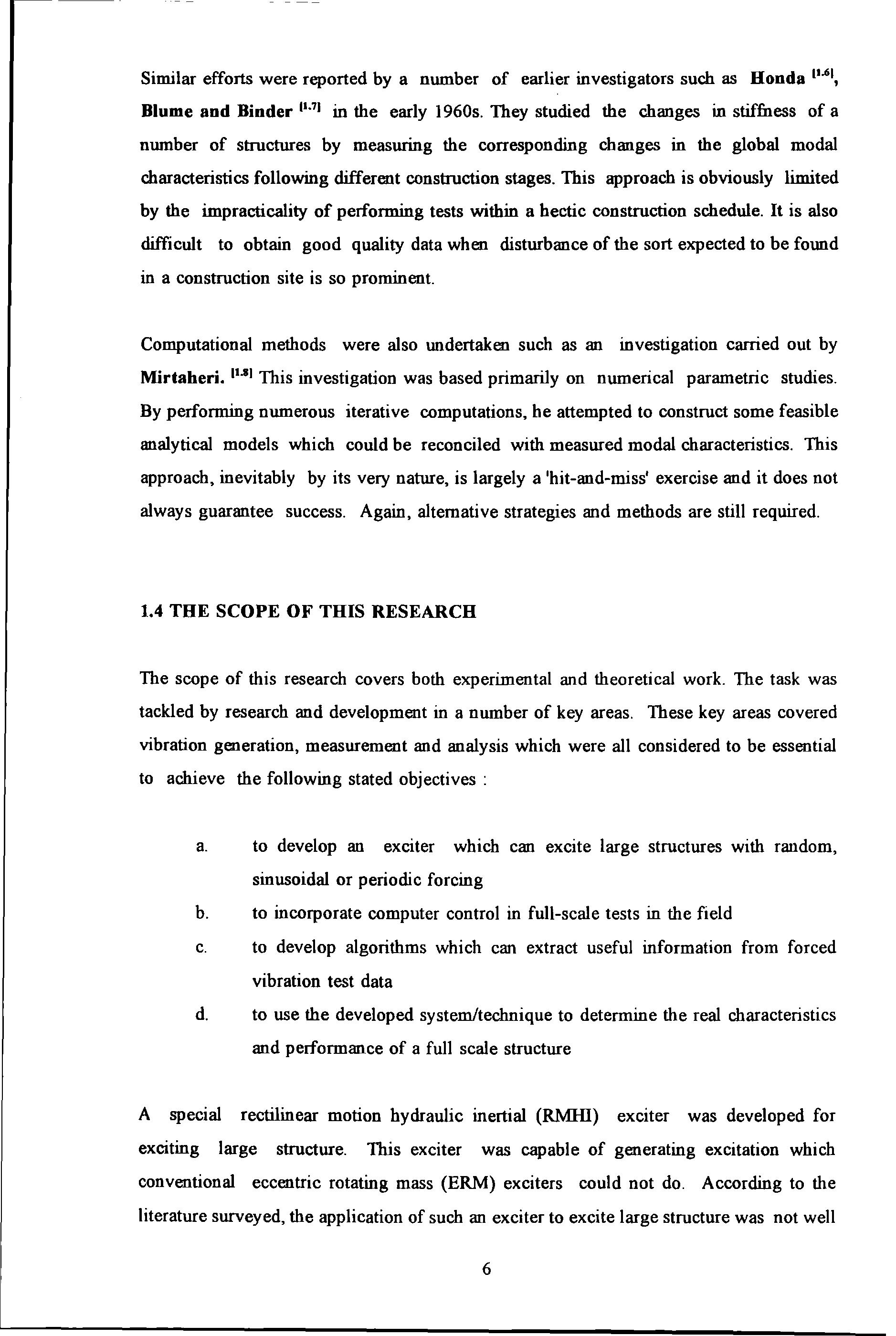
A special rectilinear motion hydraulic inertial (RMHI) exciter was developed for exciting large structure. This exciter was capable of generating excitation which conventional eccentric rotating mass (ERM) exciters could not do. According to the literature surveyed, the application of such an exciter to excite large structure was not well documented. This research used this exciter on two civil engineering structures using both periodic random as well as step-sine (SS) excitation methods. The periodic random control signal is based on Pseudo-Random-Binary-Sequence (PRBS) technique. The two structures tested cover different types of building and structural systems: an eleven-storey reinforced concrete (RC) frame-shear-wall office building, and a slender RC frame tower used for fire fighting training.
In accordance with the stated objectives, a so-called computer-aided-testing (CAT) system was also developed. This system was formed by integrating a number of experimental facilities with a desk top computer which provided centralised automatic control of equipment and fast digital data processing and recording. With this system, the required test sequences could be pre-programmed and the correct setting of various testing instruments be 'switched' remotely and precisely by the computer under the control of a program. This system not only reduced testing time tremendously but also allowed better quality data to be obtained because the error-prone task of manual operation was alleviated. The CAT system was an essential and indispensable part of this research srnce the requirement of a large amount of useful data could not be satisfied without it .
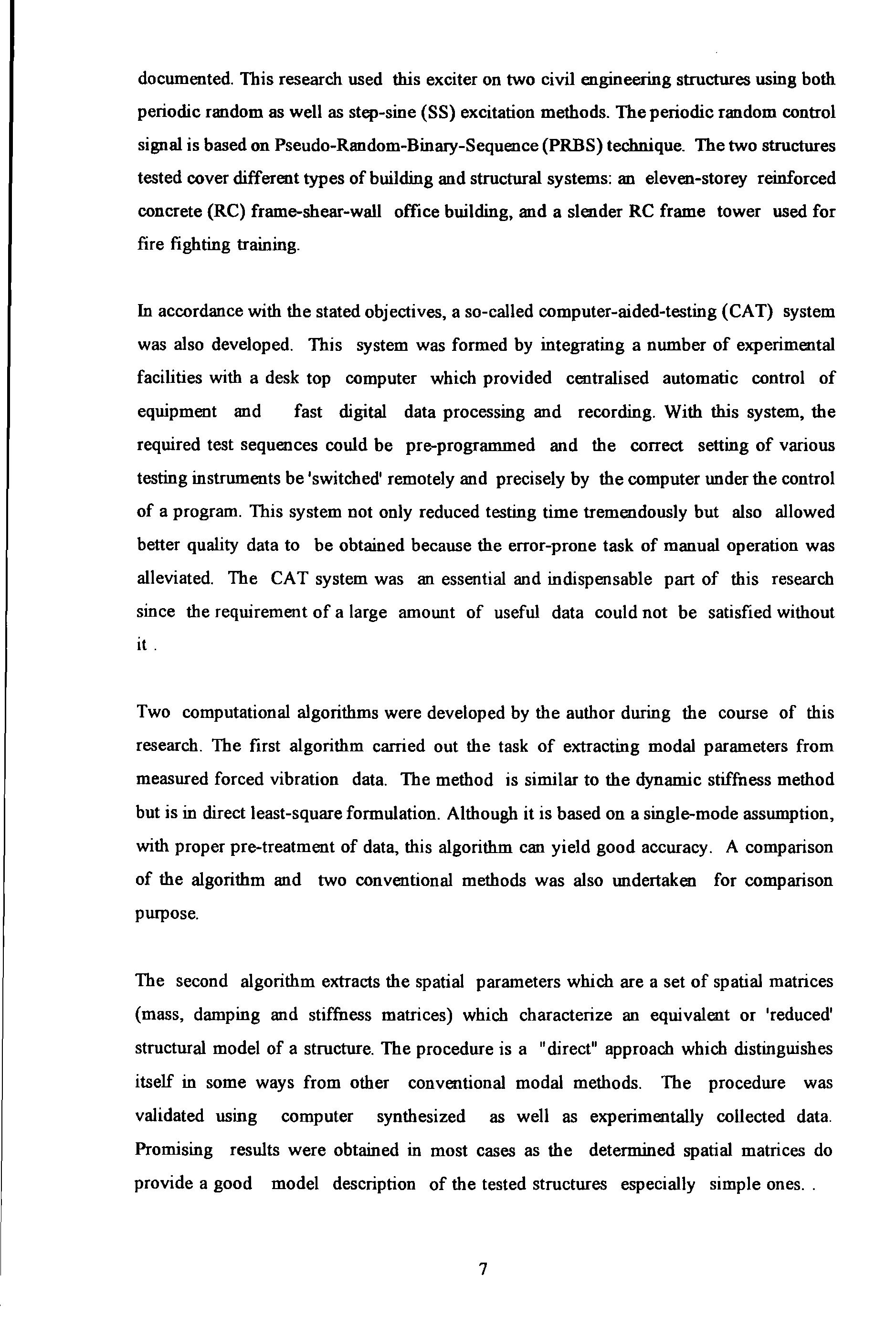
Two computational algorithms were developed by the author during the course of this research. The first algorithm carried out the task of extracting modal parameters from measured forced vibration data. The method is similar to the dynamic stiffness method but is in direct least-square formulation. Although it is based on a single-mode assumption, with proper pre-treatment of data, this algorithm can yield good accuracy. A comparison of the algorithm and two conventional methods was also undertaken for comparison purpose.
The second algorithm extracts the spatial parameters which are a set of spatial matrices (mass, damping and stiffness matrices) which characterize an equivalent or 'reduced' structural model of a structure. The procedure is a "direct" approach which distinguishes itself in some ways from other conventional modal methods. The procedure was validated using computer synthesized as well as experimentally collected data. Promising results were obtained in most cases as the determined spatial matrices do provide a good model description of the tested structures especially simple ones ..
By following much the same principle, this research found that similar matrices can be derived using Strain Frequency Response data instead of Motion Frequency Response data. These matrices were also shown to be capable of providing a good model at least for the simple beam specimen tested. However, only the works using the "Motion" data are presented.
This investigation was intended to lay the ground work by solving much of the fundamental hardware and software requirements for full scale forced vibration tests. It was intended that the system developed could be used as a 'work-horse' for further investigations in the future. Results of the tests on the two structures are presented as test cases for the advocate technique.









